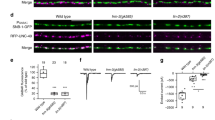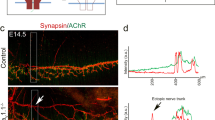Abstract
Precise synaptogenesis is crucial to brain development, and depends on the ability of specific partner cells to locate and communicate with one another. Dynamic properties of axonal filopodia during synaptic targeting are well documented, but the cytomorphological dynamics of postsynaptic cells have received less attention. In Drosophila embryos, muscle cells bear numerous postsynaptic filopodia (‘myopodia’) during motoneuron targeting. Here we show that myopodia are actin-filled microprocesses, which progressively clustered at the site of motoneuron innervation while intermingling with presynaptic filopodia. In prospero mutants, which have severe delays in axon outgrowth from the CNS, myopodia were present initially but clustering behavior was not observed, demonstrating that clustering depends on innervating axons. Thus, postsynaptic filopodia are capable of intimate interaction with innervating presynaptic axons. We propose that, by contributing to direct long-distance cellular communication, they are dynamically involved in synaptic matchmaking.
This is a preview of subscription content, access via your institution
Access options
Subscribe to this journal
Receive 12 print issues and online access
$209.00 per year
only $17.42 per issue
Buy this article
- Purchase on SpringerLink
- Instant access to full article PDF
Prices may be subject to local taxes which are calculated during checkout



Similar content being viewed by others
References
Goodman, C. S. Mechanisms and molecules that control growth cone guidance. Annu. Rev. Neurosci. 19, 341–377 (1996).
Zheng, J. Q., Wan, J. & Poo, M.-M. Essential role of filopodia in chemotropic turning of nerve growth cone induced by a glutamate gradient. J. Neurosci. 16, 1140–1149 (1996).
Kater, S. B. & Rehder, V. The sensory-motor role of growth cone filopodia. Curr. Opin. Neurobiol. 5, 68–74 (1995).
Saitoe, Y., Song, W.-J. & Murakami, F. Preferential termination of corticorubral axons on spine-like dendritic protrusions in developing cat. J. Neurosci. 17, 8792–8803 (1997).
Smith, S. J. Dissecting dendritic dynamics. Science 283, 1860–1861 (1999).
Harris, K. M. Structure, development, and plasticity of dendritic spines. Curr. Opin. Neurobiol. 9, 343–348 (1999).
Lendvail, B., Stern, E. A., Chen, B. & Svoboda, K. Experience-dependent plasticity of dendritic spines in the developing rat barrel cortex in vivo. Nature 404, 876–881 (2000).
Wu, G. Y., Zou, D. J., Rajan, I. & Cline, H. Dendritic dynamics in vivo change during neuronal maturation. J. Neurosci. 19, 4472–4483 (1999).
Maletic-Savatic, M., Malinow, R. & Svoboda, K. Rapid dendritic morphogenesis in CA1 hippocampal dendrites induced by synaptic activity. Science 283, 1923–1927 (1999).
Ziv, N. E. & Smith, S. J. Evidence for a role of dendritic filopodia in synaptogenesis and spine formation. Neuron 17, 91–102 (1996).
Fischer, M., Kaech, S., Knutti, D. & Matus, A. Rapid actin-based plasticity in dendritic spines. Neuron 20, 847–854 (1998).
Keshishian, H., Broadie, K., Chiba, A. & Bate, M. The Drosophila neuromuscular junction: a model for studying synaptic development and function. Annu. Rev. Neurosci. 19, 545–575 (1996).
Chiba, A. Early development of Drosophila neuromuscular junction: a model for studying neuronetwork development. Intl. Rev. Neurobiol. 43, 1–24 (1999).
Suzuki, E., Rose, D. & Chiba, A. The ultrastructural interactions of identified pre- and postsynaptic cells during synaptic target recognition in Drosophila embryos. J. Neurobiol. 43, 448–459 (2000).
Bate, M. The embryonic development of larval muscles in Drosophila. Development 110, 791–804 (1990).
Yoshihara, M., Rheuben, M. B. & Kidokoro, Y. Transition from growth cone to functional motor nerve terminal in Drosophila embryos. J. Neurosci. 17, 8408–8426 (1997).
Bate, M. in The Development of Drosophila Melanogaster (eds. Bate, C. M. & Martinez Arias, A.) 1013–1090 (Cold Spring Harbor Press, New York, 1993).
Johansen, J., Halpern, M. E. & Keshishian, H. Axonal guidance and the development of muscle fiber-specific innervation in Drosophila embryos. J. Neurosci. 9, 4318–4332 (1989).
Verkhusha, V. V., Tsukita, S. & Oda, H. Actin dynamics in lamellipodia of migrating border cells in the Drosophila ovary revealed by a GFP-actin fusion protein. FEBS Lett. 445, 395–401 (1999).
Murray, M. J. & Whitington, P. M. Effects of roundabout on growth cone dynamics, filopodial length, and growth cone morphology at the midline and throughout the neuropile. J. Neurosci. 19, 7901–7912 (1999).
Landgraf, M., Bossing, T., Technau, G. M. & Bate, M. The origin, location, and projections of the embryonic abdominal motoneurons of Drosophila. J. Neurosci. 17, 9642–9655 (1997).
Vaessin, H. et al. prospero is expressed in neuronal precursors and encodes a nuclear protein that is involved in the control of axonal outgrowth in Drosophila. Cell 67, 941–953 (1991).
Grabham, P. W. & Goldberg, D. J. Nerve growth factor stimulates the accumulation of β1 integrin at the tips of filopodia in the growth cones of sympathetic neurons. J. Neurosci. 17, 5455–5465 (1997).
Kaufmann, N., Wills, Z. P. & Van Vactor, D. Drosophila Rac1 controls motor axon guidance. Development 125, 453–461 (1998).
Ramirez-Weber, F. A. & Kornberg, T. B. Cytonemes: cellular processes that project to the principal signaling center in Drosophila imaginal discs. Cell 97, 599–607 (1999).
Gao, F. B., Brenman, J. E., Jan, L. Y. & Jan, Y. N. Genes regulating dendritic outgrowth, branching, and routing in Drosophila. Genes Dev. 13, 2549–2561 (1999).
Luo, L. et al. Differential effects of the Rac GTPase on the Purkinje cell axons and dendritic trunks and spines. Nature 379, 837–840 (1996).
Chiba, A. Live visualization of neurons and muscles inside an embryo. Cell Technol. 18, 852–853 (1999).
Moriyoshi, K., Richards, L., Akazawa, C., O'Leary, D. & Nakanishi, S. Labeling neural cells using adenoviral gene transfer of membrane-targeted GFP. Neuron 16, 255–260 (1996).
Doe, C. Q., Chu-LaGraff, Q., Wright, D. M. & Scott, M. P. The prospero gene specifies cell fates in the Drosophila central nervous system. Cell 65, 451–464 (1991).
Campos-Ortega, J. A. & Hartenstein, V. The Embryonic Development of Drosophila Melanogaster (Springer, Berlin, 1985).
Broadie, K. S. & Bate, M. Development of the embryonic neuromuscular synapse of Drosophila melanogaster. J. Neurosci. 13, 144–166 (1993).
Suzuki, E. & Hirosawa, K. Immunolocalization of a Drosophila phosphatidylinositol transfer protein (rdgB) in normal and rdgA mutant photoreceptor cells with special reference to the subrhabdomeric cisternae. J. Electron Microsc. 43, 183–189 (1994).
Reynolds, E. S. The use of lead citrate at high pH as an electron-opaque stain in electron microscopy. J. Cell Biol. 17, 208–212 (1963).
Wolf, B. & Chiba, A. Axon pathfinding proceeds normally despite disrupted growth cone decisions at CNS midline. Development 127, 2001–2009 (2000).
Grenningloh, G., Rehm, E. J. & Goodman, C. S. Genetic analysis of growth cone guidance in Drosophila: fasciclin II functions as a neuronal recognition molecule. Cell 67, 45–57 (1991).
Acknowledgements
We thank Vladislav Verkusha and Hiroki Oda (University of Kyoto), Andrea Brand (Cambridge University) and Chris Doe (University of Oregon) for gifts of fly stocks, Mike Kim and Xiaomao Zhu (University of Illinois) for help with data collection and Tom Kornberg and Felipe Ramirez-Weber (UCSF), Jim Campanelli (University of Illinois) and members of the Chiba lab for comments on the manuscript. This work was supported by grants from CREST JST (E.S.) and from NIH, NSF and the Lucille P. Markey Charitable Trust (A.C.).
Author information
Authors and Affiliations
Corresponding author
Rights and permissions
About this article
Cite this article
Ritzenthaler, S., Suzuki, E. & Chiba, A. Postsynaptic filopodia in muscle cells interact with innervating motoneuron axons. Nat Neurosci 3, 1012–1017 (2000). https://doi.org/10.1038/79833
Received:
Accepted:
Issue Date:
DOI: https://doi.org/10.1038/79833
This article is cited by
-
Regulatory mechanisms of cytoneme-based morphogen transport
Cellular and Molecular Life Sciences (2022)
-
Regulation of axon regeneration by the RNA repair and splicing pathway
Nature Neuroscience (2015)
-
Nogo-B is associated with cytoskeletal structures in human monocyte-derived macrophages
BMC Research Notes (2011)
-
Characterisation of the role of Vrp1 in cell fusion during the development of visceral muscle of Drosophila melanogaster
BMC Developmental Biology (2010)
-
Muscle and neuronal differentiation in primary cell culture of larval Mytilus trossulus (Mollusca: Bivalvia)
Cell and Tissue Research (2010)




